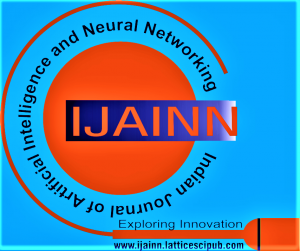![]()
A Comparative Analysis of Diabetes Prediction using Different Machine Learning Algorithms
Srinivas Mishra1, Aruna Tripathy2
1Srinivas Mishra, Research Scholar, Department of Electronics and Instrumentation Engineering, Odisha University of Technology and Research, Bhubaneswar (Odisha), India.
2Prof. (Dr). Aruna Tripathy, Professor, Department of Electronics and Instrumentation Engineering, Odisha University of Technology and Research, Bhubaneswar (Odisha), India.
Manuscript received on 23 July 2022 | Revised Manuscript received on 04 August 2022 | Manuscript Accepted on 15 August 2022 | Manuscript published on 30 August 2022 | PP: 1-7 | Volume-2 Issue-5, August 2022 | Retrieval Number: 100.1/ijainn.E1057082522 | DOI: 10.54105/ijainn.E1057.082522
Open Access | Ethics and Policies | Cite | Mendeley | Indexing and Abstracting
© The Authors. Published by Lattice Science Publication (LSP). This is an open access article under the CC-BY-NC-ND license (http://creativecommons.org/licenses/by-nc-nd/4.0/)
Abstract: The endocrine disorder diabetes is a condition where the body’s glucose levels are abnormally high. Diabetes type II is highly prevalent among elderly people. Worldwide, this number is rising quickly. Furthermore, diabetes creates major health issues that might result in organ failure and paralysis in addition to lowering the blood glucose content. Additionally, it shortens the patients’ lives [1]. Early diabetes classification involves seeing a patient at a diagnostic facility and consulting doctors, which is a very time consuming process. A mechanism has been created to deal with these significant problems. A classification of the patient’s level of diabetes using machine learning (ML) algorithms has been addressed in this paper. Previous works considered only five different ML algorithms. We have extended and compared the classification of diabetes prediction using eight different ML algorithms. The database used to train the models is taken from the Pima Indian Diabetes datasets as available from the UCI ML repository [2]. Accuracy, Precision, recall, and F1 score are the four metrics that have been used to analyze and compare the performances of prediction. In comparison to other methods, simulation results indicate that the Neural Network model has the highest accuracy, at 93%. Another performance metric has been the receiver operating characteristics (RoC) that also shows that NN has the maximum area among all the eight algorithms. Simulation results show this area as 0.740.
Keywords: Machine learning, Logistic regression, Gaussian Naive Bayes, Decision Tree, Neural Network, Support Vector Classifier, Artificial Neural Network. K-means, Gradient boosting classifier, K-Nearest Neighbor
Scope of the Article: Neural Networks
